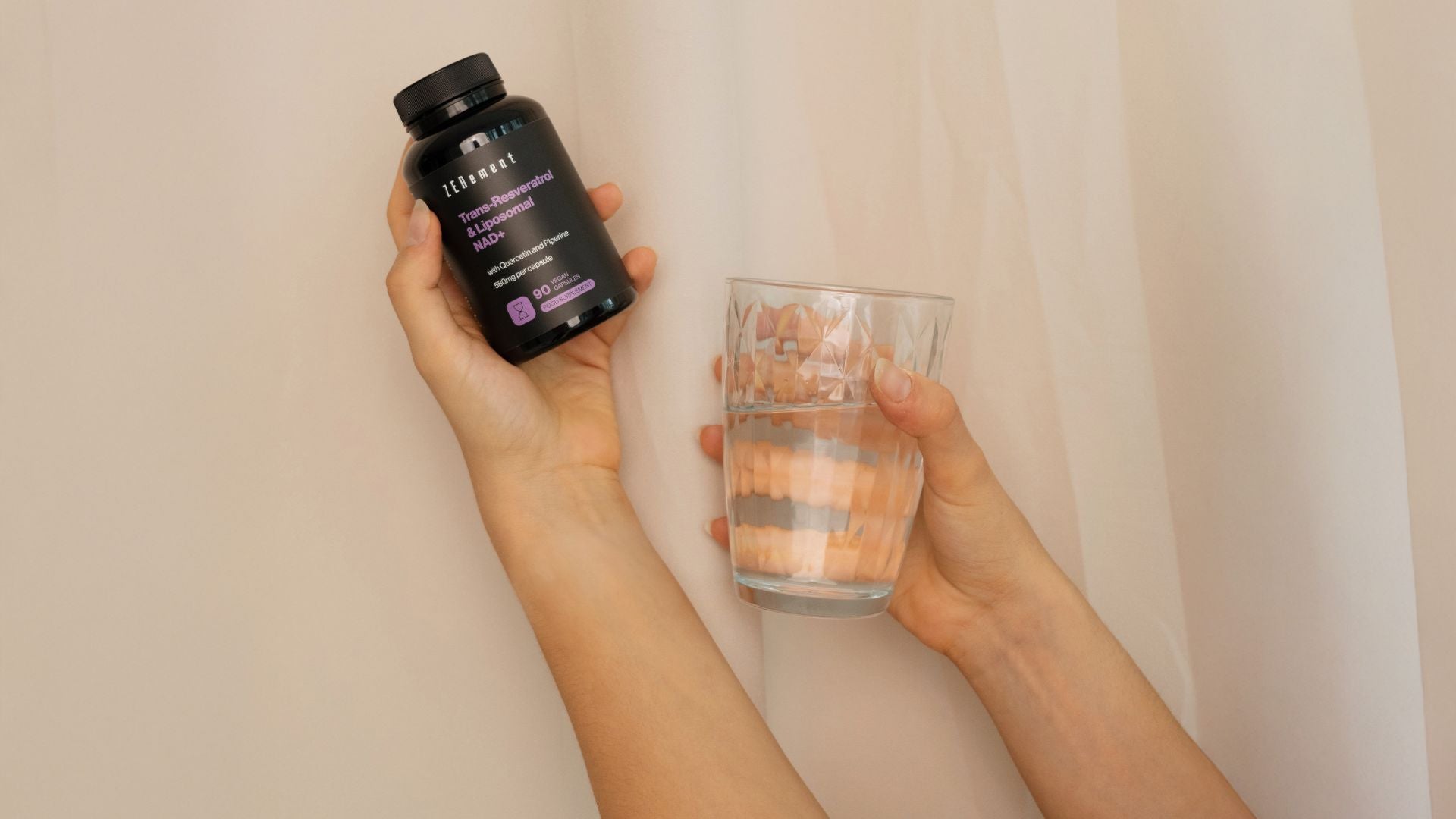This post is focused on resveratrol and quercetin, two molecules with anti-ageing effects. They do not act as simple antioxidants, but their mechanism of action is based on the activation of SIRT1, a gene of the sirtuin family. They are therefore also known as sirtuin activating compounds or STACs (Sirtuin Activating Compounds). Sirtuins control ageing through DNA repair, and are normally activated when the body lacks nutrients (i.e. when we fast). Therefore, the main virtue of these molecules is to mimic the effects of fasting.
We will also discuss the cofactor NAD (Nicotinamide Adenosine Dinucleotide), which is essential for sirtuin activity, and how we can increase its levels to boost the effectiveness of Resveratrol and Quercetin.
Trans-Resveratrol
It is a polyphenol that is naturally present in the skin of red grapes, currants, blackberries and peanuts, and is also found in high concentration in Fallopia japonica root (Polygonum cuspidatum), a shrub with healing properties.
By activating sirtuins, its main effect is that of gene repair. The expression of SIRT1 is also associated with increased insulin sensitivity, which is why trans-resveratrol has been shown in human studies to significantly reduce fasting glucose, a very important effect in preventing ageing.
In addition, it has also been shown to have cardiovascular health benefits, helping to reduce LDL (bad) cholesterol and increase HDL (good) cholesterol.
The doses of trans-resveratrol studied range from a minimum of 250 mg/day to a maximum of 2000 mg/day.
|
Did you know…? That “a glass of wine every day” is not as healthy as we’ve been told. We’ve all heard that red wine contains resveratrol and that a glass of wine every day can be beneficial to our health. However, the correct answer is that to consume an adequate amount of resveratrol to obtain these benefits, we would need to drink hundreds of glasses of wine, and therefore the alcohol intake would be too high and would seriously endanger our health. Nowadays, resveratrol is purified from grapes or Fallopia japonica root to obtain a highly concentrated extract. |
Quercetin
Quercetin is a natural flavonoid found in red wine, onions, green tea, apples or berries, and in the Sophora japonica (Japanese Acacia) flowers.
Its main function is senolytic, i.e. it helps to eliminate senescent or ‘old’ cells that are resistant to apoptosis (programmed cell death). These ‘zombie’ cells can no longer divide or perform their functions, but they do not die either, and secrete oxidative and inflammatory molecules that damage tissues. Quercetin therefore has an antioxidant effect, helping to keep tissues ‘clean’.
Doses studied are up to 1000 mg quercetin per day.
Several studies suggest a synergistic effect between resveratrol and quercetin. In other words, their combined effect is greater than the sum of their separate effects. For example, in a study on the effect of these molecules on body fat accumulation, administration of resveratrol or quercetin separately did not induce significant reductions in adipose tissue weight. In contrast, the combination of both molecules led to a significant reduction in all the fat stores tested.
|
Did you know…? That fisetin is a flavonoid very similar to Quercetin. In fact, it also activates SIRT1 and has the same senolytic properties. It is found together with quercetin in the same foods as previously mentioned, with high levels found especially in strawberries. David Sinclair combines them both in his routine, dividing the recommended 1000 mg into 500 mg quercetin + 500 mg fisetin. |
Sirtuin and NAD activation
As mentioned previously, NAD is a coenzyme involved in a number of metabolic reactions, and that is closely linked to sirtuin activation; it is the “fuel” they need in order to function.
Levels of NAD and and the protein synthesised by the gene SIRT1 are naturally highest in our bodies around midday, so it is advisable to take Resveratrol or Quercetin in the morning or mid-morning (11 a.m. – 12 p.m.).
NAD is synthesised in our bodies from nicotinamide (vitamin B3) and can also be synthesised from its intermediates, NR and NMN.
How to increase NAD levels?
Increasing NAD biosynthesis is an indirect strategy to activate the sirtuin pathway, because we increase one of its substrates.
As we age, NAD supplementation is of interest, as the body synthesises less NAD.
Nicotinamide
Nicotinamide is a form of vitamin B3. It can be found in foods such as pulses, oily fish and nuts, as well as in multivitamins and other food supplements. Once taken, the body will synthesise NAD by adding a sugar (ribose) and a phosphate group to this molecule.
Nicotinamide riboside
Nicotinamide riboside (NR) is a small molecule that can be easily absorbed by cells because its structure consists of vitamin B3 bound to a sugar (ribose). It is found in small amounts in milk.
Doses studied to increase blood levels of NAD range from 250 mg to 1000 mg per day.
Because it activates the sirtuin pathway, NR is credited with anti-inflammatory properties, blood glucose regulation, increased insulin sensitivity and synthesis of more mitochondria.
Nicotinamide mononucleotide
Nicotinamide mononucleotide (NMN) is a molecule which is slightly larger than NR.
David Sinclair‘s lab proved that NMN is more effective than NR with the same daily doses of 250mg-1000mg. Why is this? It is the precursor that is closest to NAD synthesis. This means that our body does not have to struggle to find the missing “pieces of the puzzle” of this molecule (in this case phosphate, which is rare in the body). By simply joining 2 molecules of MNM together, we obtain NAD.
Preliminary studies prove that it increases insulin sensitivity, increases endurance and vitality and improves mitochondrial function, showing great potential to be used in humans.
Below is a diagram of how NAD is obtained:

Source: Yoshino, J., Baur, J. A., & Imai, S. (2018). NAD + Intermediates: The Biology and Therapeutic Potential of NMN and NR. Cell Metabolism, 27(3), 513–528. doi:10.1016/j.cmet.2017.11.002.
|
IMPORTANT: While Nicotinamide is an accepted source of vitamin B3 and is easily found on the market, NMN is not allowed to be marketed in Europe. In contrast, NR has recently been approved as a Novel Food, but exclusively available from a single company until February 2025. |
Zenement Formulas with Trans-Resveratrol and Quercetin
Here are our anti-ageing formulas containing the molecules mentioned in this post:
Trans-Resveratrol by Zenement
Our product contains 500 mg of Trans-resveratrol per capsule, so one capsule per day is enough. It is the most stable and effective form of this polyphenol, extracted from Polygonum cuspidatum with a purity level of 98%.
In addition, our formula also contains other ingredients that boost Trans-resveratrol’s effect:
- NAD, the endogenous cofactor directly involved in the activity of the sirtuin pathway.
- Quercetin, another STAC with powerful antioxidant effects.
- Piperine, an alkaloid found in black pepper that increases the absorption of the ingredients found in this formula.
How to use: 1 capsule each day (breakfast or midday).
Warnings and Interactions:
Moderate interaction with anticoagulant or antiplatelet drugs, as it may slow the clotting process.
|
Tips for taking Trans-Resveratrol: Resveratrol in powder form is very insoluble and hydrophobic, so if you pour it into a glass of water, it will sink to the bottom of the glass. You can take it in capsules or open the capsule and mix the powder with yoghurt or olive oil (which also activates the sirtuin pathway thanks to polyphenols such as oleuropein, tyrosol and hydroxytyrosol) so it dissolves properly. In line with this, studies have shown that if resveratrol is taken with a meal, resveratrol levels rise more quickly in the blood. Sinclair also advises taking your dose of resveratrol in the morning/midday because, as mentioned earlier, according to our circadian rhythms, this is the time of day when there is a natural increase in NAD activity and the sirtuin pathway. |
Quercetin by Zenement
Each of our formula’s capsules contains 500 mg of pure quercetin, sourced from the Sophora japonica flower. We combine it with bromelain, an enzyme extracted from pineapples that improves absorption; it is also good for joints and muscles.
How to use: 1 capsule per day, preferably with a meal (e.g. breakfast or lunch).
Due to its synergistic effect, we recommend taking it together with Trans-Resveratrol.
Warnings and Interactions:
Quercetin has a number of moderate interactions with anti-inflammatory drugs such as Diclofenac or Voltaren (slowing their breakdown), drugs to treat hypertension such as Losartan (modifying their absorption and breakdown) and anticoagulants such as Warfarin (increasing their effects).
Other food supplements that can help you achieve healthy ageing are Berberine, which acts in our body by directly activating the AMPK pathway, and Spermidine an autyophagy promoter molecule.


